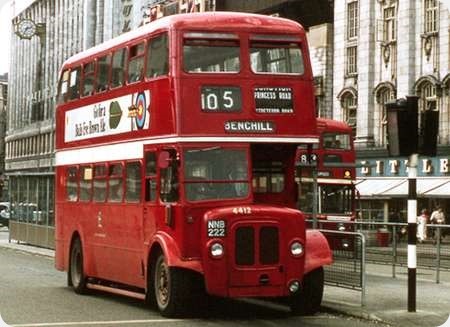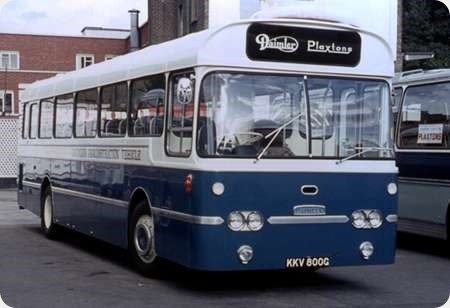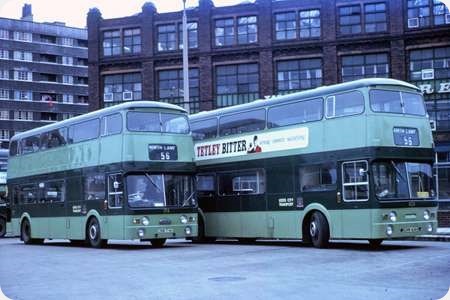
Manchester Corporation
1953
Daimler CVG6
Metro Cammell H32/28R
During the 1950s, Manchester Corporation mainly sourced its double deck fleet from Leyland, the shorter PD2 chassis being preferred, and from Daimler, mostly the CVG6 version, but some CVG5s were also taken. The picture, taken in June 1970 after the formation of the SELNEC PTE in November 1969, shows Daimler CVG6 No. 4412, NNB 222 with Metro Cammell H32/28R body carrying Manchester’s version of the tin front. Some sources refer to these buses as CVG6K, in recognition of the fitment of the upgraded Gardner LW ‘K’ type engine that emerged from 1950, but I am not sure that this was an official Daimler designation.
Photograph and Copy contributed by Roger Cox
31/05/21 – 09:07
Did the addition of a ‘K’ suffix to the designation of a Daimler CV series not indicate use of a Kirkstall rear axle?
David Call
02/06/21 – 08:38
Yes, David, you are absolutely correct. An absurd error on my part. Daimler began using Kirkstall rear axles on resumption of production in 1942. Daimler axles reappeared as an option at the end of the war, when the suffix became ‘D’.
Roger Cox
04/06/21 – 06:11
The bodywork on this bus is perhaps the most un-Metro Cammell looking product I’ve ever seen. Was this particular design unique to Manchester Corporation?
Chris Barker
04/06/21 – 06:11
I began my student days in Manchester in September 1971 and these were my regular steeds down the A34 Wilmslow Road and Palatine Road to my "Manchester home" in the Withington/West Didsbury area. They were a little tired and slow but, as South Manchester is basically on the flat Cheshire plain, they were still remarkably up to the job. Twenty years – not at all a bad innings.
David Oldfield
05/06/21 – 05:31
Chris is correct in suggesting that this body design was unique to Manchester – in fact it was unique to this batch of 80 buses, all later Met-Cams being Orions.
Just to clarify Roger’s description, these were all delivered with standard Birmingham-style tin fronts. The home-grown style shown was only fitted to some vehicles as a replacement when the original was damaged.
Peter Williamson
06/06/21 – 06:28
They were a Manchester special – with flush windows for machine washing – but I believe that they are a development of the Phoenix style which preceded them. Rather like the spray painted "all red" livery which ruined Manchester’s discreetly distinguished earlier livery, this was a watered down version the classic Phoenix. Sadly, standards slipped until the "Mancunian" era.
David Oldfield
07/06/21 – 06:23
They say beauty is in the eye of the beholder. Evidently so is ‘tired and slow’-ness. Like David Oldfield I came to Manchester University (in 1970 rather than 1971) my previous experience of bus travel having been L5G (to 1965) and MW5G types on some very winding city streets where 20 mph was the usual maximum. I thought these Daimlers had very good acceleration helped I think I’m right in saying from memory by a preselect gearbox and also good top speed.
Peter Cook
08/06/21 – 05:57
In his comment about the Dennis Loline I back in 2013, Ian Thompson said that the genuine 112 bhp of the Gardner 6LW was worth 125 bhp of anyone else’s. Remember that this figure was generated at 1700 rpm, at which speed the bigger AEC and Leyland units would have putting out around 118 bhp, not a lot more. Indeed, if Gardner had increased the revs of the 6LW to 1850 as it did with the 6LXB, the output would have been around 120 bhp. The Gardner had a very flat torque curve right across the rev range, and the correct way to drive one was to change up early and let the torque accelerate the bus, rather than scream the engine up to maximum revs. In addition to later vehicles, I’ve driven Leyland PD2 and 3, AEC Regent III and V, and Daimler CVG6 (plus the Halifax CVL6) and in my book the Gardner handsomely beats Preston and (sorry David) Southall.
Roger Cox
10/06/21 – 07:07
As we’re on a Manchester thread, it should be mentioned that Manchester’s PD2s and CVG6s were both de-rated to 100bhp at 1650rpm. By common consent the Leylands were livelier, and for that reason worked on the northern side of the city where the hills were.
Peter Williamson
17/06/21 – 06:48
I’m not sure whether Northenden or Parrs Wood was the most southerly depot, but Parrs Wood was predominantly if not totally Leyland. The Burlingham bodied PD2s were lively performers particularly the final few ‘non-standards. From the mid-fifties the 92 Manchester-Hazel Grove was generally a Daimler either as above or newer. Stockport shared this service using 1949 or 1951 all Leyland PD2/1s. There was no comparison in performance, the Leylands were fast and lively, the Daimlers were very sluggish which shows the effect of down rating. Our local route was usually a 1949 PD2. Crossleys could not keep time, the only other vehicles that could keep time were the prewar TD4s.
Andrew Gosling
17/06/21 – 15:25
Yes, I had forgotten about Parrs Wood. Manchester had two northern depots, one eastern and four southern, so keeping all the Leylands in the north and east would not have been possible. But the point is that the CVGs did not work in the north, with the notable exception of the Phoenixes on cross-city services, until about 1966. After that it seemed anything could be cascaded anywhere.
Peter Williamson



